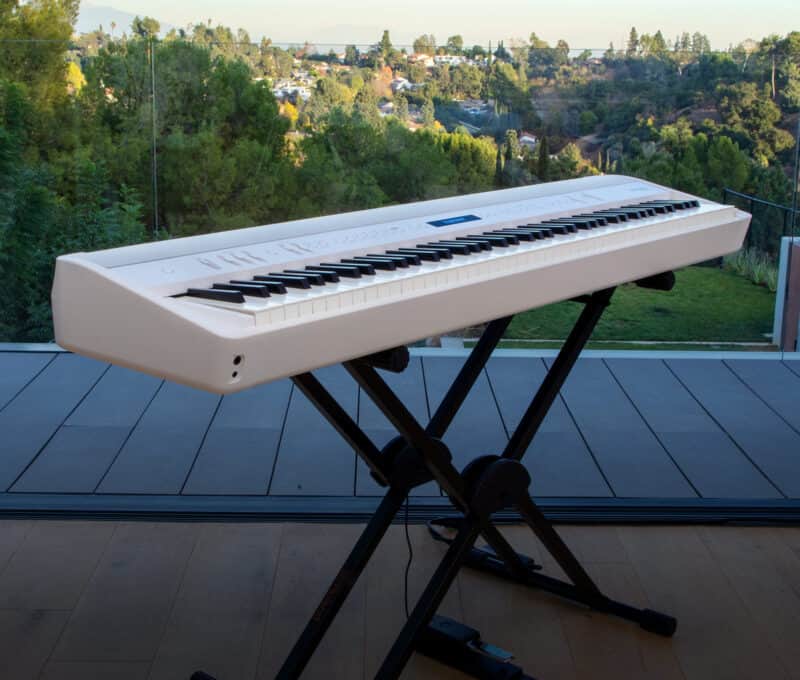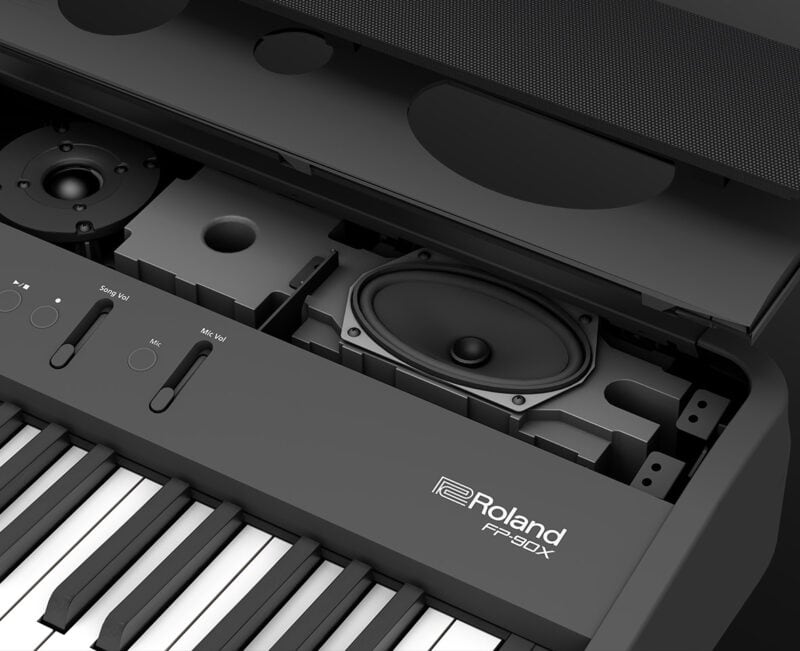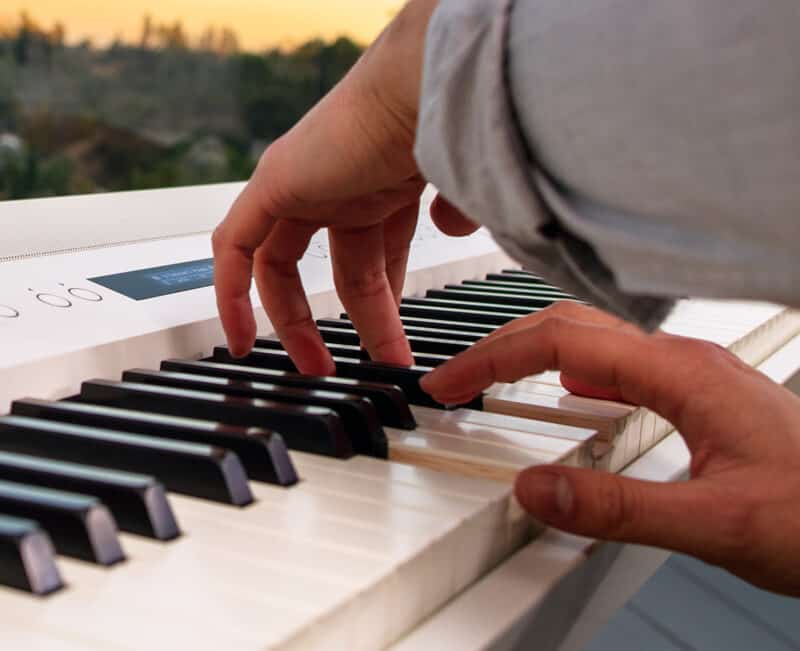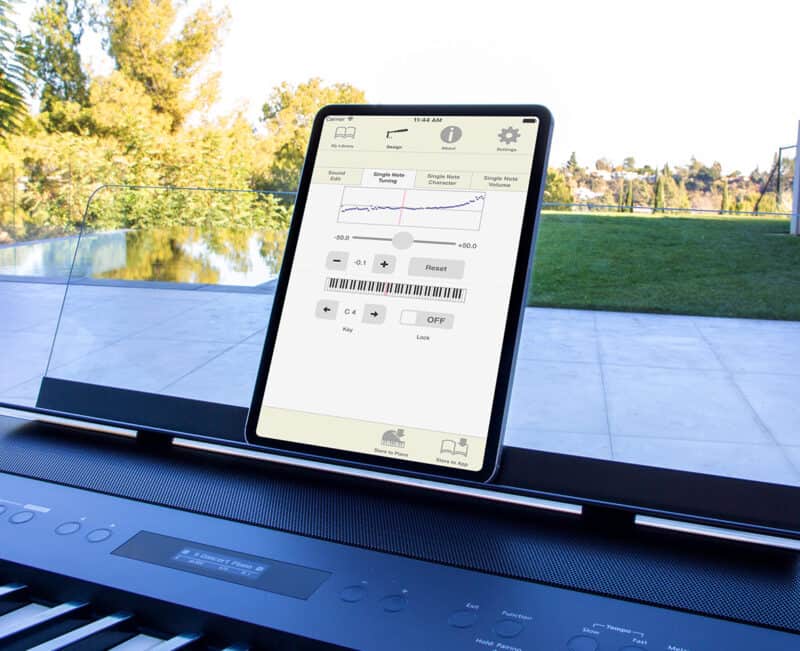All-in-one portable 88-note digital pianos were once considered a fairly niche instrument, with more traditional stage pianos being far more popular. In the last few years, however, sales volume of portable all-in-one units have skyrocketed, with Roland, Yamaha and Kawai leading the pack.
Roland’s flagship model in this category was the FP-90 for the past several years, however, it has now been replaced by the upgraded FP90X.
Like the FP-90 before it, the FP90X is more impressive from a specs standpoint as compared to the equivalent Yamaha and Kawai offerings, the P-515 and ES-920 respectively, but also the most expensive.
In today’s review, we’re going to dive right into the FP90X to see how it follows up on the hugely successful and class-leading FP-90. Let’s get into it.
Roland FP-90X – Background

As we mentioned above, the FP90X is the follow-up to the Roland FP 90, which itself was a very full-featured, highly capable portable digital piano, largely built to offer musicians a very authentic acoustic piano playing experience in a portable format.
It had a great set of onboard speakers, three-band EQ sliders for real-time mixing, Roland’s great wood/plastic hybrid PHA50 action, and full piano modeling. In fact, it was Roland’s first portable instrument to offer a modeled piano sound.
So, how does the FP-90X build on this already strong foundation? Let’s have a look.
What’s New?
PureAcoustic Piano Modeling Sound Engine
The first thing that jumps out about the FP-90X is that it has received a brand new sound engine – the PureAcoustic Piano Modeling Engine. Thanks to the new BMC sound chip that is gradually making its way into most Roland models, they were able to increase the complexity of the modeling algorithm, resulting in the creation of this new sound engine.
What is modeling you ask? Piano modeling means that the piano sound is produced and generated in real time by a computer algorithm. Traditionally, most sound engines were sample-based which means that a real piano was recorded and used as the basis for the sound, so when a piano key is pressed, this recording is what plays.
There are arguments that go both ways in terms of which methodology creates the most authentic piano sound, so there isn’t a single objectively correct answer. One advantage of modeling however is limitless polyphony, which is the case here with acoustic piano tones. While this might be overkill for many situations, it does speak to the power of the approach.
Of course, to convincingly execute this approach a very fast processor is required, and the BMC chip is more than up to the task. While the piano tone is not as complex as some of the very best VSTs out there, this is undoubtedly a very complex tone engine.
My Stage
One of the other introductions that the 90X brings that was not present on the 90 is the new My Stage feature. My Stage really is essentially a series of presets that offer different configurations of the PureAcoustic modeling algorithm.
There are 12 different presets available in the My Stage feature, including things like Hall Stage, Lakeside Studio, Impressionistic and Church Concert. Each offers a distinctly different character and flavor from the other giving users quick and easy control over the piano sound.
Built-In Speakers

One of the classing leading specs of the FP-90 was its powerful 4-speaker (2 mains and 2 tweeters) 60-watt speaker system – easily outpowering anything in the category. The rated power output on the 90X remains the same, however, Roland has added tone ports to the back of the instrument which disperses the treble frequencies, reducing some harshness that was present on the 90.
Given the sheer power of the amps, there are certainly gigging and rehearsal situations where you would be able to get away without having to bring an external amp along, so this sound system is sure to be a key reason some people choose an FP-90X.
Musical Impressions
Now that we’ve got the significant upgrades out the way, let’s move on to a look at some of our more personal, musical observations of the sound.
Piano Sound
For starters, we can plainly say that the new speaker design paired with the new sound engine has really improved the overall dynamic range of the instrument, particularly in lower dynamic ranges. This was an area where the FP-90 arguably lagged behind the Kawai ES-8 and ES-920.
The mid-range has some really beautiful cabinet resonance, and again, this wasn’t the case with the FP-90. The treble could be a bit glassy and harsh as we mentioned above, but again, Roland has addressed this and eliminated the problem here.
Piano Designer
Thanks to the new sound engine, they’ve also upgraded the user’s ability to edit the acoustic piano tone via the Piano Designer function. A particularly cool editable parameter is soundboard type, which actually has a huge effect on the sound of the piano tone.
Other parameters like damper noise, string resonance, key-off noise, and a number of other parameters as well.
Of course, you can also tweak the sound in real-time courtesy of the equalizers, and edit more macro effects like ambience.
Other Sounds
In addition to the 20 different acoustic piano sounds, there are 300 additional sounds covering a wide variety of instruments, and these are delivered via the SuperNATURAL piano sound engine, with 384 notes of polyphony.
There are 18 core electric piano sounds, and this is an area where the 90X really shines, particularly the e-piano Rhodes sound with a percussive, almost guitar-like texture. There’s a nice modulation effect you can apply here too.
There are also 18 organ sounds, and 27 core strings/pads. After this, we can get into 279 various synth and miscellaneous sounds. The FP-X series pianos don’t have full synthesizer functionality in terms of shaping and morphing the sound, but having such a wide selection makes up for that to some extent.
Piano Action

PHA-50 Keyboard Action
Whereas the FP-30X and FP-60X use the PHA4 hammer action – a fine action in its own right – the FP-90X gets a significant boost by being the only FP series piano to feature the PHA-50 wood/plastic hybrid action.
Durability & Key-stick Length
There are a number of reasons we really happen to like this action. For one, it’s a seemingly indestructible action with incredible long-term durability thanks to the use of wood and a stabilizer pin. For professionals who play more contemporary styles, the keys tend to experience much more lateral pressure as compared to classical playing, and some actions are known to have their keysticks break under this pressure, such as the Yamaha GHS action.
This stabilizer pin protects the PHA-50 from key breakage and allows the action to hold up very well over time.
Secondly, the key stick itself is much longer on the PHA50 than the PHA4, in fact, the pivot point is almost the same as a grand piano. There are Roland digital pianos with even longer keysticks, but none are available in a portable format.
Key Textures, Escapement & Triple Sensor
The PHA-50 features a number of other impressive specs that deserve mentioning, such as an Ivory Feel key texture on the white keys, and a matte finish on the black keys. Having some type of texture on the keys is a staple for higher-end key actions for a better tactile experience.
The PHA-50 also has escapement, which is the added physical sensation you’ll feel when playing an acoustic grand piano action. Most pianists agree it also adds a level of control when playing in lower dynamic ranges.
Finally, there’s also triple sensor key detection, and this gives the action a wide degree of touch sensitivity and makes it great for any type of triggering due to its accuracy.
Action Wrap Up
Some other observations about this action are that the responsiveness and repetition speed are really good and that the key dip feels a little bit shallow.
We do need to add one word of caution though. The newer Roland actions feel quite a bit different from the Roland actions of the past, so if you’re used to those older Roland actions, you’ll want to play this one first before you buy. Odds are you’d get used to it anyway if you weren’t enamoured at first, but it’s something to be aware of nonetheless.
Features/Connectivity/Accessories

Functions
The FP-90X has quite a bit going for it in the way of functions. Staples like dual, split, transpose and metronome are all present, and everything is easy to use courtesy of the nice LCD screen, so you likely won’t need a deep dive with the owner’s manual to get familiar with the instrument.
There are also volume sliders and 3-band equalizer, along with a simple recorder with playback option.
Connectivity
The 90X has a lot going on in the way of the connectors so let’s run down the line. For pedals, the 90X has a damper pedal jack, as well as a jack for an optional triple pedal unit.
There’s a stereo mini line-in, discrete 1/4” line out, as well as MIDI in and out. There are also USB Type A and B, and dual headphone ports.
As an added bonus, the 90X also has a mic input, and you’re also given a mic volume slider and gain knob.
Like the 90 before it, the 90X also has Bluetooth MIDI and Audio. Bluetooth MIDI lets you connect to smart devices and use apps such as the new Roland Piano App, which has replaced the Piano Every Day app. Bluetooth Audio makes your 90X a very powerful high-end Bluetooth speaker for streaming music.
Accessories
The FP-90X ships with the DP-10 damper pedal, music rest, power supply and owner’s manual. Roland offers some additional optional accessories such as the KSC-90 keyboard stand, KPD-90 pedal board or floating RPU-3 triple pedal.
Closing Thought
All in all, the FP-90X offers some subtle, but meaningful upgrades over the FP-90. The new sound engine and tone ports on the back of the case really improve the sound and speaker performance, and the My Stage feature gives the sound a quickly accessible range of colors.
It does come in a fair bit more expensive than the Kawai ES-920, Yamaha P515 and Casio PX-S6000, so it’s going to come down to whether or not the 90X’s classing leading specs list is worth the extra cash to you or not.
Thanks for reading!

